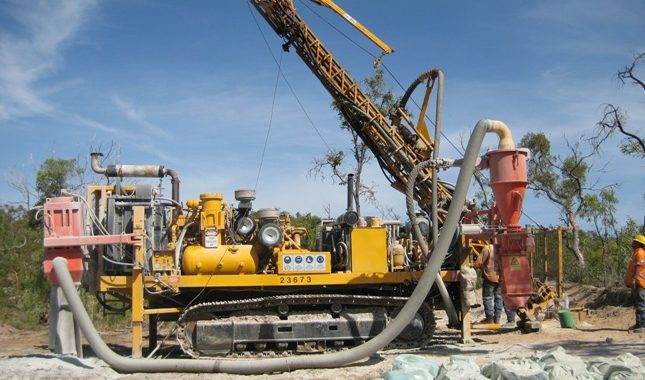Augers – Drilling Rigs (download PowerPoint)
Augers and Drilling Rigs 1 What is a Drilling Rig? A machine which creates holes in the ground with the purpose of extracting water, oil, natural gas, soil samples, etc. May be attached to a vehicle, operate as an independent machine or as a permanent structure 2 Drilling Rigs Some are self propelled Some are mounted on machines 3 Drilling Rigs :: Types Mobile or Permanent Land or Marine-based Capable of small mineral exploration and drilling 1000’s of meters deep into the earth’s mantle 4 Drilling Rigs : Types Auger Percussion Rotary Air Blast Air Core Cable Tool Reverse Circulation Diamond Core Direct Push Hydraulic Rotary Sonic 5 Auger Hole Diggers 6 What is an Auger Hole Digger? An auger hole digger is a tool used to create holes in the ground. They are powered by an electric motor or attached to a tractor which is powered by its power take off. It consists of two shovel blades hinged in a jaw-like arrangement. Each shovel blade has its own handle.
http://en.wikipedia.org/wiki/Auger
7 Drilling Rigs : History Until 19 th century, Drills of any size were used manually via man or animal power During the 1970s, Reverse Circulation Drills became efficient and feasible on a larger scale. 8 Drilling Rigs : History Evolution of rigs from man powered single holes to multiple holes at sea 9 History The modern auger was invented by Peter Pakosh. In the 1940’s at Massey Harris, Pakosh approached the design department, with his auger idea but was told that his idea was unimaginable. However, he went on to design and build the first prototype auger in 1945, and 8 years later started selling tens of thousands of them under the “Versatile” name. http://en.wikipedia.org/wiki/Auger 10 Drilling Rigs : Useage in Construction Water Wells Caissons Blasting Operations Core Samples 11 Drilling Rigs : Other Useage Natural Resources – Oil – Natural Gas Test Wells – Sinkhole Testing 12 Drilling Rigs : Safety Concerns Contact with overhead and or underground utilities Struck by and caught in between related incidents Rollover related incidents Improper use Inexperienced operators Hearing protection 13 Drilling Rigs : Statistics on Fatalities 35 Fatalities Source: Extracted from OSHA Accident Investigation Data 1990-2007 14 Drilling Rigs : Statistics on Fatalities Most Common Fatality: Failure to keep safe distance from overhead utilities which leads to electrocution for those simply touching machinery. 15 Drilling Rigs : Typical Cases 16 Drilling Rigs : Typical Cases 17 Drilling Rigs : Safety Procedures Things will be wet and muddy- use three points of contact when climbing on the rig Be careful of slipping due to muddy conditions 18 Uses in Construction In construction, auger screws can be used for special drilling rigs to dig holes for deep foundation piles. They can also be used for forming piles and for a piling retaining wall http://en.wikipedia.org/wiki/Auger 19 Typical Hazards It is essential that everyone involved in the assembly, operation, transport, maintenance, and storage of this equipment be aware, concerned, prudent, and properly trained in safety. The majority of accidents involve entanglement on the driveline or auger. This entanglement risk becomes greater when workers replace shear bolts with bolts longer than those specified by the manufacturer. This improper replacement occurs most often on machines that are loaned or rented to someone who has not read the owner’s manual and is not familiar with the auger. http://www.danuser.com/safety/safetynew.htm 20 Inspections Machines should be inspected before and after each use. This will prevent any injuries from occurring, as well as prolong the life of the hole digger and auger. After holes have been dug, it is important to make sure that they are covered up or roped off to prevent people from falling and injuring themselves. 21 Fatalities Two workers were in the process of digging 3 holes, approximately 7′ deep and 30″ wide, for the installation of a new sign. One worker was operating a digger derrick truck. The digger was rear center-mounted . At the 3rd hole, they hit concrete at the 64 inches depth. As in the preceding hole- the worker got into the hole, With a rotating hammer, he started to break up the concrete. He loaded the broken concrete into a bucket and removed it from hole. He then got out of the hole. The operator saw him standing nearby and proceeded to place the auger back in and to continue digging. The operator stated that the victim began walking east of the holes, while he was pulling up and swinging the auger westward then north to spin off the dirt. The operator then swung the auger back to the 3rd hole and began digging again. The operator pulled up the auger and saw the victim attached to it. The operator did not know that the victim had returned to the hole. The victim’s tape measure was found in the hole. Information obtained from OSHA Investigation data 1990-2007 22 Fatality Example A worker was in the process of digging post holes to install a security fence on the employer’s property. The worker was using a tractor with a post hole digger (auger) attached. The worker walked around to apply pressure to the guide on the auger. The auger was not provided with guards and shields. The worker’s clothing (left pant leg and shirt) became entangled in the auger’s driver shaft, causing his left leg to be twisted and amputated below the knee. His body was thrashed around the auger numerous times which caused his head to apparently strike the frame-work (driveline) of the auger. Information obtained from OSHA Investigation data 1990-2007 23 Drilling Rigs : OSHA Regulations 1926 800 N : Clearance from power lines should be at a minimum of 10’ if line is under 50kV, 10 feet plus .4 inches per kV over 50 kV (Same as 10 feet plus 1 foot per 30 kV over 50 kV) spotter to be designated to observe clearance between equipment and lines. 1926 800 S : Competent Person shall inspect machinery, site, and setup prior to use. 24 OSHA Standards Keep all guards in place when the machine is in operation. [1928.57] Make sure everyone is clear of machinery before starting the engine, engaging power, or operating the machine. [1928.57] Lock out electrical power before performing maintenance or service on equipment. [1928.57] Use approved methods of guarding. [1928.57] Equip all tractors with an agricultural tractor master shield on the rear power take-off. [1928.57] http://www.osha.gov/SLTC/youth/agriculture/machinery.html 25 OSHA Standards Guard power take-off equipment to protect employees from contact with positively driven rotating members of the power drive system. [1928.57] Follow accident prevention signs and tags [1910.145]: Provide and post reflective “Slow Moving Vehicle” emblem on all slow moving vehicles (tractors, combines, etc.), (25 m.p.h. or less) that travel on public roads [1910.145] see 1928.21. http://www.osha.gov/SLTC/youth/agriculture/machinery.html 26 Safety Precautions Before operating a drilling rig, the operator must read and understand all the information in the owner’s manual and in the safety signs attached to the product. A person who has not read or understood the owner’s manual and safety signs is not qualified to operate the rig. http://www.danuser.com/safety/safetynew.htm 27 Safety Precautions Drilling rigs are designed for one-man operation. Always dig holes while sitting in the tractor seat. Never operate the rig with anyone near, or in contact with, any part of the implement, PTO driveline, or auger. Accidents have occurred when more than one person is in the immediate area of the operating equipment. Be sure no one else, including bystanders, are nearby when drilling. http://www.danuser.com/safety/safetynew.htm 28 Safety Precautions Do not operate the drilling rig unless all shields and guards are in place. Never replace the shear bolt or auger retaining bolt with one longer than those supplied and specified by the manufacturer. See the owner’s manual. Do not use the rig unless the auger point and cutting edges are intact and in good working order. http://www.danuser.com/safety/safetynew.htm 29 Drilling Rigs : Safety Procedures Wear all applicable PPE with regards to electrocution and struck by hazards Be careful of loose clothing that could get caught in the drilling rig 30 Drilling Rigs : Safety Procedures Note all applicable power lines, determine minimum safe distance, designate a spotter to make sure safe distance is actually maintained at all times 31 Drilling Rigs : Safety Procedures Observe all safety practices with regards to proper operation of machinery, safe distances to maintain, and proper maintenance and inspection practices. Be cognizant of weather conditions; e.g. thunderstorms provide an additional risk of electrocution. 32 Drilling Rigs : Safety Procedures 33 Safe Work Practices Make sure employees who operate equipment are appropriately trained and physically able to operate it safely. Develop a “safety first” attitude. Follow safe work practices all the time and set a good example for others. Make sure workers are physically and mentally fit to operate machinery. Fatigue, stress, medication, alcohol, and drugs can prevent workers from safely operating equipment. . http://www.osha.gov/SLTC/youth/agriculture/machinery.html 34 Safe Work Practices Allow workers to take frequent breaks. Fatigue, stress, and worry can distract them from safely operating equipment. Ensure machinery has proper machine guarding and shielding. Provide appropriate personal protective equipment such as gloves, dust masks, and ear protection for employees. Ensure employees wear hearing protection during exposures to high-intensity noise. http://www.osha.gov/SLTC/youth/agriculture/machinery.html 35 THINK SAFETY WORK SAFELY 36

